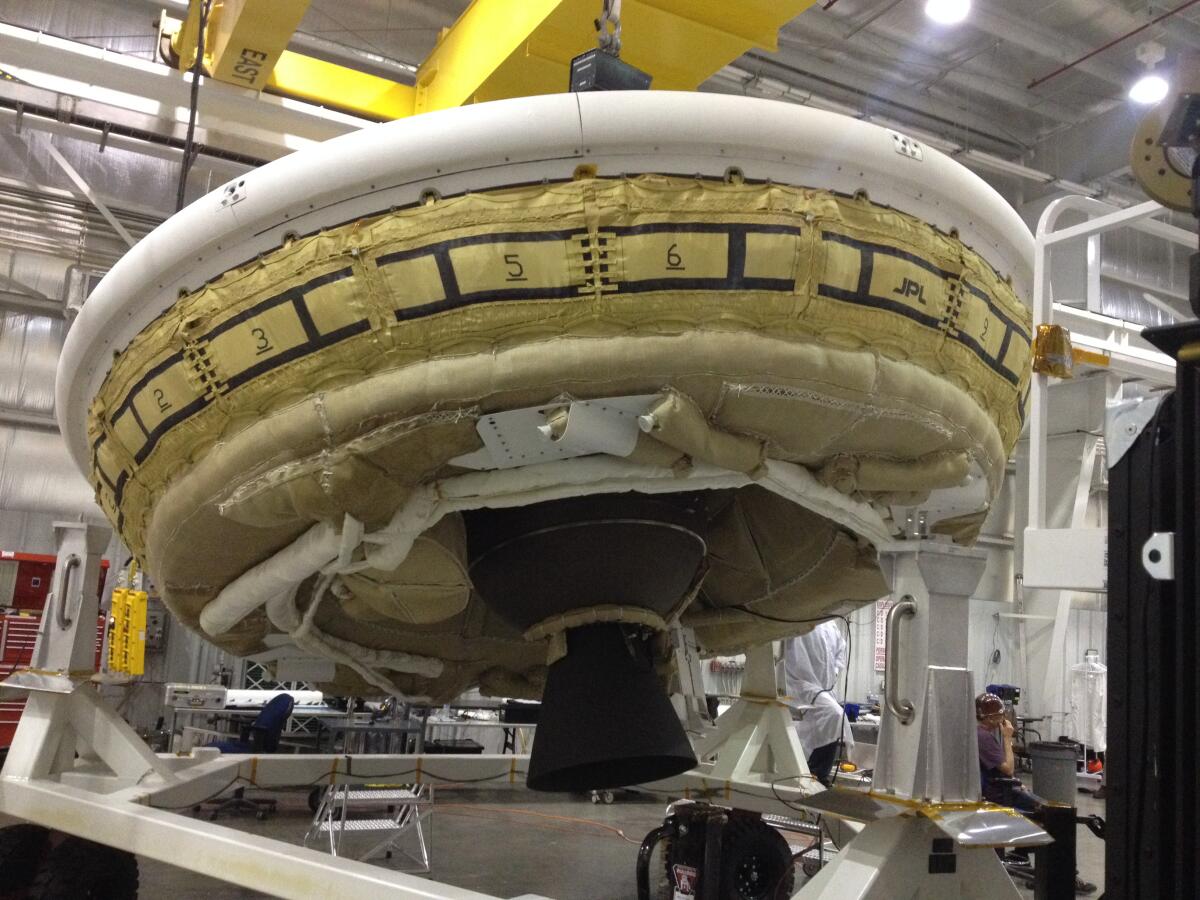Simulating a Martian landing in the sky above Hawaii

On a cloudless day in early June, Mark Adler stood facing the empty maw of the Pacific, contemplating invisible winds high above his head. For two years, he had pored over meteorological data from around the world in search of a sweet spot. That search landed him here, at the remote Pacific Missile Range Facility on the far western tip of Kauai.
Here, at this time of year, the winds did exactly what he wanted. Usually.
Adler has worked as an engineer and program manager at NASA’s Jet Propulsion Laboratory for more than 20 years, mostly on missions to Mars. He now heads a new project with a mouthful of a name — the Low-Density Supersonic Decelerator, known in the acronym-strewn world of NASA as LDSD. Adler just calls it “the device.”
Its purpose is simple: to slow a heavy object hurtling toward the surface of Mars at four times the speed of sound. If humans ever set foot there — or, for that matter, land anything heavier than the Curiosity rover — something like the LDSD must exist. However, building it, testing it and successfully deploying it is anything but simple.
“Mars is actually a tricky place to land,” said Philip Christensen, a geologist at Arizona State University who studies the Red Planet. The thin atmosphere can’t provide substantial drag, yet it creates enough friction to burn up objects that enter it.
Four years into the project, Adler has grown intimately familiar with the challenges of pushing the technological envelope. He experienced a significant one this month.
Abnormal wind patterns stymied plans to conduct the first full-scale LDSD test in Hawaii. Adler’s team needed strong winds high in the atmosphere to blow the device over the ocean where the supersonic test could take place. Instead the winds gusted stubbornly onshore, putting populated areas in jeopardy.
“We rolled the dice and didn’t win,” Adler said. But this was just one of many hurdles he’s faced.
Resurrected from the notebooks of early aerospace engineers, the LDSD differs from existing technology in that it takes a two-pronged approach to not crashing into Mars.
Like the system that delivered Curiosity, it will still deploy a parachute (one significantly bigger and stronger), but only after an inflatable doughnut expands around the vehicle. This air bag will increase its area by at least 60%, creating more drag and slowing it down from spaceflight velocities of Mach 4 to more modest speeds of Mach 2.5, when the chute can safely be released. Only then can the rest of the landing sequence begin.
The idea for inflatable decelerators emerged in the 1960s, when scientists on the Viking mission knew little about the Martian atmosphere and what it might take to land there.
They soon realized they could get by with just a parachute, leaving more exotic designs hidden inside aging technical reports. In 1972, NASA forged ahead with parachute tests that became the basis for every subsequent mission to Mars.
When NASA launched the Curiosity rover in 2011, engineers finally reached the limits of its decades-old system.
“If we want go bigger, bolder and more capable, we need something new,” said Ian Clark, who specializes in designing entry, descent and landing systems like the LDSD.
If it works, the new vehicle will be able to ferry loads weighing up to 3 metric tons to the surface of Mars — twice the capacity of the Curiosity mission.
The NASA team scientists have come to Hawaii to see whether they’re on the right track.
Normally, they’d put a new landing system inside a wind tunnel and test its toughness at the supersonic speeds it would encounter in space. But with a parachute over 100 feet wide, the LDSD outgrew every wind tunnel. Even the 20-foot-wide doughnut couldn’t squeeze into a facility capable of simulating Mach 4 forces.
“We are essentially trying to build a wind tunnel in the upper atmosphere,” where the thin air approximates conditions on Mars, said Grace Tan-Wang, the operations lead, who oversees the practical implementation of the project.
This isn’t the first clever trick the team has used. It tested the durability of the inflatable doughnut by shooting it down a railroad track on a rocket sled at the China Lake Naval Air Weapons Station in the Mojave Desert. It survived.
Then the team tested the parachute by tethering it to a rocket sled and yanking it to Earth from a height of 4,000 feet. It didn’t survive.
On Kauai, the scientists hope to test the system in something approximating its intended environment.
First they need to escape Earth’s “pea soup” atmosphere, as chief engineer Rob Manning put it. They’ll hitch the vehicle to a balloon and float it to the upper reaches of the stratosphere, about 120,000 feet, or 22 miles, above Hawaii’s pounding surf. The test is planned for Saturday.
They will only launch if winds will carry the balloon — a high-altitude model that would feel cramped in the Rose Bowl — and its odd payload out over the ocean. The balloon, usually used to lift telescopes above the grime of the lower atmosphere, will release the device so that it points away from the island and its people.
Once free, LDSD’s rocket engines will roar to life, sending the vehicle 8 miles higher. Then it will level out and blaze sideways through the thin atmosphere at Mach 4, exactly as it would on Mars. Its doughnut should inflate and its parachute unfurl, shepherding it safely back to Earth.
At least, that’s the plan.
From launch to splashdown, the vehicle will be aloft for most of a day, but the supersonic portion of the flight will last just 5 minutes, Tan-Wang said.
The test will reveal not only whether LDSD has a future on Mars, but whether the blue skies over Hawaii make a suitable testing ground.
Tan-Wang said friends and family are often shocked when she explains that NASA projects take years, even decades, of planning and preparation, and that so much effort can go toward an incremental test. But she sees it in reverse: This one project will enable a new generation of space exploration.
“It will probably live way beyond my lifetime,” she said.
LDSD stands apart from other technologies developed by NASA because it has taken shape outside the context of a specific mission. It received about $200 million in funding from the Space Technology Mission Directorate, a new branch of the agency’s research arm charged with anticipating the needs of the space-faring community.
Christensen, the Arizona State geologist, said they’ve hit the mark with LDSD: “Anything NASA can do to increase the amount of mass you can land on the surface is important.”
Practically speaking, landing more mass will reduce the price tag of missions to Mars, since great effort goes into miniaturizing all the instruments on the rovers, he said.
It will also allow researchers to accomplish goals they have long dreamed of. Scientists are eager to collect rocks and fly them home. But this requires putting a rocket on the surface of Mars, and with the current weight constraints, such a small rocket could only bring home about one pound of samples.
If LDSD works, grander schemes start to seem attainable.
“There are a lot of us that really want to see humans go to the surface of Mars, and these are the kinds of technologies needed to get us there,” Christensen said.
If the winds blow the right way, sometime Saturday three tractor tugboats roughly 100 miles west of Kauai will fish the LDSD and its balloon out of the Pacific. Scientists will scour the data collected by the flight sensors to learn whether the vehicle reached the right speeds and the decelerators deployed at the right times.
Clark gives the test a 30% chance of success. But the team doesn’t necessarily see failure as a bad outcome.
“My boss said, ‘If everything works perfectly on your flight, you get an A, but if you see problems, you get an A+,’” Adler said. “Because that showed that I pushed it to the limit.”
Twitter: @ScienceJulia






